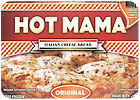
Product Spotlight
Hot Mama Bread microwaveable breadsIf you hear someone exclaim, “Hot mama!” on the street, they’re probably not talking about the Toledo, Ohio, company’s newest Italian cheese bread. But if you hear this expression - and you also smell warm garlic, herbs and cheese and a microwave is somewhere in the vicinity - it could very well be in reference to Hot Mama Bread’s new microwaveable gourmet Italian cheese breads.
This June saw Hot Mama Bread add two new microwaveable varieties: Original and Garlic.
“This new product represents all of the unique, great-tasting and innovative Italian flavors that Hot Mama Bread provides, with the added factor of convenience and simplicity,” says President Michael Barone.
Marking Hot Mama’s fifth new product launch, the microwaveable bread comes frozen in a 7.5-ounce box and is made with fresh tomatoes, basil, garlic and mozzarella and Romano cheeses.
“The product is perfect for both the family and the individual because it can be served as a snack, appetizer or meal,” Barone says. “Families and individuals who are busy or on-the-go will find it convenient because it is prepared in the microwave in less than two minutes.
He also adds that the breads are made by hand using a recipe that imparts a “light and airy crust” while maintaining crispy edges and a soft center.
Hot Mama’s new microwaveable bread is available at grocery stores in 18 states and distributed nationally at Wal-Mart stores - along with the company’s other products including 14.5-ounce varieties of Original, Garlic and Bruschetta Italian cheese breads.
“The new product is different from other Hot Mama product in that it can be ready-to-eat quicker - under two minutes - while retaining the same delicious taste,” adds Barone.

Supplier Spotlight
CFS’ GigaSlicerThe name of the game in food processing? Increased productivity at a lower cost. Because food processors worldwide share that same objective, CFS B.V., Bakel, The Netherlands, invested its research and development into a product that delivers the best of both worlds.
And among the company’s offerings this spring at Interpack 2008 in Dusseldorf, Germany, CFS introduced the GigaSlicer. With a slicing area of 550 millimeters by 210 millimeters, officials say the CFS GigaSlicer is the largest in its class - able to slice one lane more than conventional machines. As an example, it can accommodate five 110 millimeter diameter sausages instead of just four.
“The extra performance delivered by the CFS GigaSlicer helps meat and cheese processors operate more cost effectively,” said Jorg Schmeiser. “And when used together with the CFS PowerPak NT - currently the only thermoformer that can complement the CFS GigaSlicer’s performance - sliced portions are packed at a higher capacity than comparable combinations on the market today. This really brings the cost per package down.”
Officials say the machine features a patented idle cut rotor that avoids sliver slices and guarantees consistent slice thickness. The knife also is easily adjusted to the ideal position for a specific application by moving the rotor head in x-y directions. In addition, the CFS GigaSlicer handles 3.2-meter long products and can quickly be reloaded.
CFS says it also paid special attention to hygiene and maintenance concerns. Engineers designed the GigaSlicer so that the product zone is separated from the machine’s control and drive zones. This minimizes contamination issues and simplifies cleaning. Main components are easily accessible, the company says, while most parts that come into contact with the product may be removed - without tools - for cleaning. This improves sanitation, speeds up maintenance and reduces operational costs.
CFS North America Inc., Frisco, Texas, represents the company to U.S. food processors.
Can new refrigerated, frozen products tap "local" angle?
A trend linking a major retailer with a growing restaurateur? Local foods. Wal-Mart, Bentonville, Ark., and Chipotle Mexican Grill Inc., Denver, announced plans to buy and promote more local produce. For its part, Wal-Mart said its partnerships with local farmers have grown by 50 percent during the past two years, and that’s one example of how the company is trying to support local economies, cut shipping costs and provide fresh food offerings. The retailer estimates that locally sourced fruits and vegetables account for a fifth of produce available at Wal-Mart during summer months. Elsewhere, Chipotle claims to be the only national restaurant chain committed to local produce on a significant scale. Company officials said that Chipotle will purchase 25 percent of at least one of its produce items for each of its 730+ stores from small and mid-sized local farms.Trend watcher: More opportunity in the deli
There is an opportunity for retailers to capitalize on a trend toward restaurant-sourced snacks, which accounted for about $12.1 billion in sales last year. That was just one of several suggestions put forth during the International Dairy-Deli-Bakery Association’s recent annual convention in New Orleans.Elizabeth Sloan, president of Sloan Trend Inc., said “healthy snacks” topped retail shoppers’ wish lists for new deli department items. Sloan presented just a few of the findings from an IDDBA-commissioned study titled, “Health & Wellness 2008: The Purpose Driven Consumer.” Sloan also noted that (1) parents surveyed said they were most interested in more healthy kids’ snacks in the in-store and bakery departments and (2) one in five consumers have replaced restaurant take-out with supermarket prepared foods. These consumers also are looking for healthier alternatives to traditional restaurant meals.
Using sweeteners? A word about high fructose corn syrup
The Corn Refiners Association (CRA) launched a multimedia ad and public relations campaign to address what association officials say has been “considerable attention and misinformation” about high fructose corn syrup (HFCS).CRA officials said a recent national survey (conducted by The MSR Group) indicates that the myths associated with this sweetener have led many consumers to believe that it is different from table sugar.
Moreover, high fructose corn syrup often is labeled “unnatural” and is accused of being uniquely responsible for obesity. The survey showed that:
- More than two-thirds of consumers do not know that HFCS and table sugar have the same number of calories;
- Only 19 percent of survey respondents understand that table sugar and HFCS have the same sweetness;
- Almost two-thirds of those surveyed do not understand that HFCS contains the same simple sugars - glucose and fructose - as table sugar.
CRA officials note that the caloric density of HFCS and sugar are equal at four calories per gram.
“No single food or ingredient is the cause of obesity,” said James Rippe, a cardiologist and biomedical sciences professor at the University of Central Florida. “Eating too many calories and getting too little exercise are the primary causes.
“There is no difference in how the body metabolizes these sweeteners,” he continued. “They’re indistinguishable once they reach the bloodstream.”
Just the facts
Overweight teenagers and “tweens” say they would make better food decisions if they were available. According to a recent study, a majority,79 and 78 percent,respectively, of obese and overweight members of Generation M (those born between 1980 and 2000) said that they think it’s a very good idea for schools to offer healthy grab-and-go snacks and healthier portions of their favorite foods including pizza, burgers and fries.Source: Shugoll Research and Midan Marketing’s Gen M Obesity: Understanding tween and teen obesity – causes, effects and solutions from their perspective
Noticing more sugar-free products on grocery shelves? It’s not just your imagination. Frequency and awareness of diabetes is on the rise in the U.S. Today, an estimated24 million people - or 8 percent of the population - are diabetic. In addition, the number of undiagnosed diabetic cases fell 5 percent from 2006 to 2007, meaning that diabetes awareness is on the rise.
Source: U.S. Department of Health and Human Services Centers for Disease Control and Prevention
With rising prices at the gas station and at the grocery store, it’s not just lower income families that are having trouble making ends meet these days. According to recent research,24 percent of consumers making between $55,000 and $99,000 per year say they are having difficulty buying the groceries they need. Meanwhile, 56 percent of those making $35,000 per year or less and 44 percent of those making $35,000 to $54,900 say the same.
Source: Information Resources Inc.’s “IRI Times & Trends Special Report: Competing in a Transforming Economy”